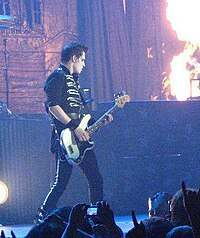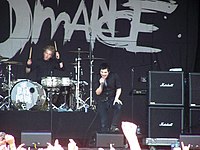Danger Days: The True Lives of the Fabulous Killjoys (2009–present)
On May 27, 2009, My Chemical Romance's web designer, Jeff Watson, announced via the band's website that the band was headed to the studio to record their fourth full-length album. The recording took place over the following few weeks with producer
Brendan O'Brien, who has worked with
AC/DC,
Mastodon, and
Pearl Jam.
In an interview with
NME, Gerard Way said the band's next record would be a rock album, saying, "I think (the next album) will definitely be stripped down. I think the band misses being a rock band."
[26] In a separate interview with
Idiomag, Way commented that the next release would be less theatrical in scope, stating that "it's not going to be hiding behind a veil of fiction or uniforms and makeup anymore."
[27] In an interview with PopEater, Way also stated that the next album will be "full of hate." He also said "over the years that we've been hearing ourselves live and hearing us on records, we kind of prefer the live. There's more of a garage feel and more energy. I'd like to capture some of that, finally. That's the goal for the next one."
[28]On July 31 and August 1, 2009, My Chemical Romance played two "secret" shows at The Roxy Theater in Los Angeles. The shows were the first concerts the band had played since
Madison Square Garden in May 2008. The band also premiered several new songs said to be from their upcoming fourth album during the shows, one reportedly titled "Death Before Disco", a song that Way said he was particularly excited about.
[29] The song was since renamed "Party Poison" and was included on the new album. Way explained further in a
Rolling Stone interview that "it's a completely different sound for the band — it's like an anti-party song that you can party to. I can't wait for people to hear it. It brings back, lyrically, some of that wonderful fiction from the first album.
[30]Gerard Way also said in a November 2009 interview with
Rock Sound that the fourth album would be their defining work. "A friend who heard the record recently said he now had no interest in listening to our older work anymore, that we had made all our old material redundant. I took it as a compliment, the next thing you should always make the last thing seem unimportant and I think that will happen when we finally release this album."
[31] On March 3, 2010, Iero announced on their official website that Bob Bryar had left the band, writing:
"As of 4 weeks ago, My Chemical Romance and Bob Bryar parted ways. This was a painful decision for all of us to make and was not taken lightly. We wish him the best of luck in his future endeavors and expect you all to do the same."[32][33]
The band did not state reasons on why he left.
In a March 2010
MTV interview about the new album, Way explained, "There's no title yet...I'm actually kind of excited about that. It's kind of 'anything goes' at this point, but I'm so happy with the songs." Though the band since decided on the title of their fourth album, it continued to go unannounced, with various rumors circulating and the band stating on their website that it will be revealed "all in due time"
[34] and in Way's words, "a special way this time. Maybe some sort of event, something fun, something soon."
During the San Diego
Comic-Con 2010, Way announced that the band had finished recording the fourth studio album.
[35] This was later confirmed by Iero on the band's website, announcing that the album was "done, finished, kaput, in the proverbial can, and being played loudly as we drive way too fast in our respective cars."
[34]In September, a trailer video was uploaded to My Chemical Romance's official
YouTube page entitled
Art is a Weapon, which announced the title of the album:
Danger Days: The True Lives of the Fabulous Killjoys. The video featured the band wearing strangely coloured outfits and battling unusual characters in a desert surrounding, and featuring a sample of music from the song "
Na Na Na (Na Na Na Na Na Na Na Na Na)". Notable comic book author and the band's personal friend,
Grant Morrison, makes a special appearance, in the role of an enemy and leader of a band of masked characters. On September 22, 2010, the band premiered their song "Na Na Na (Na Na Na Na Na Na Na Na Na)" on
Zane Lowe's
BBC Radio 1 show, and
Los Angeles-based radio station
KROQ.
[36][37] The album was released on November 22, 2010.
[38]Rock Sound had a preview of the album and gave a positive review, commenting "the way they’ve used everything they learned on ‘
The Black Parade’ and tightened up in certain places feels natural and confident" and that it sees "the creativity of the band taking flight musically, graphically and literally."
[39] Michael Pedicone joined the band as a touring drummer late in 2010, replacing Bryar.
[40] During a performance at Wembley Arena on February 12, 2011, Way announced that the band will be appearing at a UK festival later in the year,
[41] later confirmed as the
Reading and Leeds Festivals, which they headlined. They also performed at
Radio 1's Big Weekend in
Carlisle, England on May 15, 2011.










